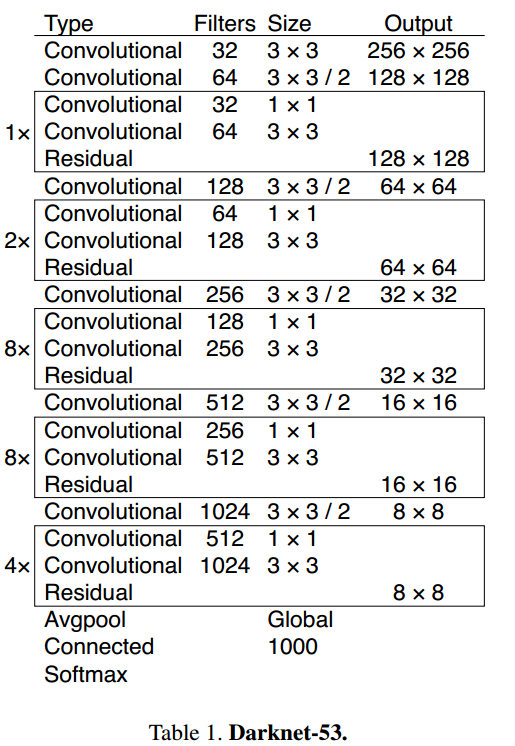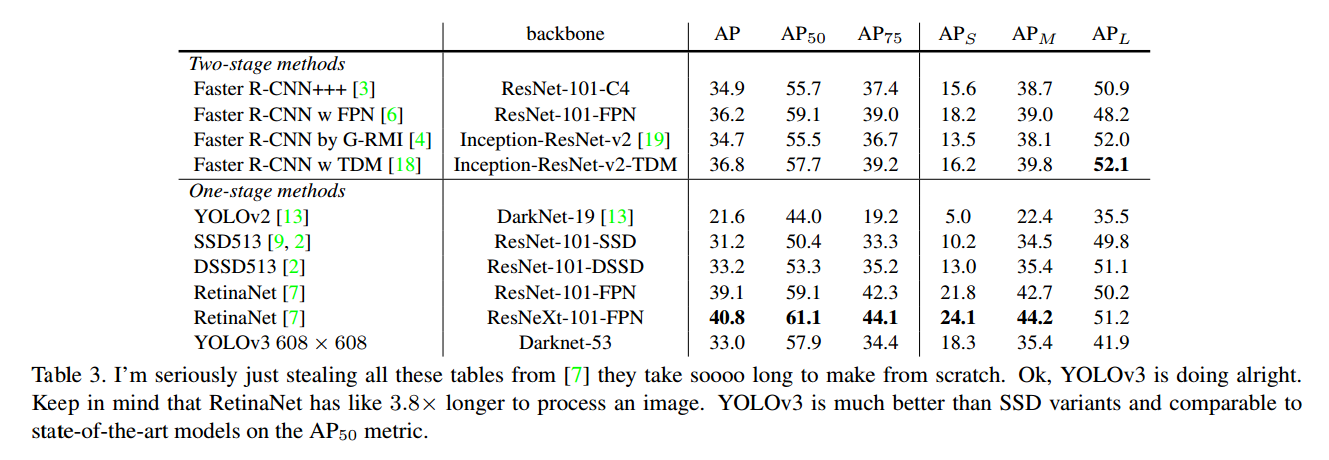论文 - YOLO v3
引自:https://xmfbit.github.io/2018/04/01/paper-yolov3/
发表于 2018-04-01
YOLO的作者又放出了V3版本,在之前的版本上做出了一些改进,达到了更好的性能。这篇博客介绍这篇论文:YOLOv3: An Incremental Improvement。下面这张图是YOLO V3与RetinaNet的比较。
可以使用搜索功能,在本博客内搜索YOLO前作的论文阅读和代码。
YOLO v3比你们不知道高到哪里去了
YOLO v3在保持其一贯的检测速度快的特点前提下,性能又有了提升:输入图像为320×320
大小的图像,可以在22ms跑完,mAP达到了28.2,这个数据和SSD相同,但是快了3倍。在TitanX上,YOLO v3可以在51ms内完成,AP50的值为57.9。而RetinaNet需要198ms,AP50近似却略低,为57.5
。
ps:啥是AP
AP就是average precision啦。在detection中,我们认为当预测的bounding box和ground truth的IoU大于某个阈值(如取为0.5
)时,认为是一个True Positive。如果小于这个阈值,就是一个False Positive。
所谓precision,就是指检测出的框框中有多少是True Positive。另外,还有一个指标叫做recall,是指所有的ground truth里面,有多少被检测出来了。这两个概念都是来自于classification问题,通过设定上面IoU的阈值,就可以迁移到detection中了。
我们可以取不同的阈值,这样就可以绘出一条precisio vs recall的曲线,计算曲线下的面积,就是AP值。COCO中使用了0.5:0.05:0.95十个离散点近似计算(参考COCO的说明文档网页)。detection中常常需要同时检测图像中多个类别的物体,我们将不同类别的AP求平均,就是mAP。
如果我们只看某个固定的阈值,如0.5
,计算所有类别的平均AP,那么就用AP50来表示。所以YOLO v3单拿出来AP50说事,是为了证明虽然我的bounding box不如你RetinaNet那么精准(IoU相对较小),但是如果你对框框的位置不是那么敏感(0.5
的阈值很多时候够用了),那么我是可以做到比你更好更快的。
Bounding Box位置的回归
这里和原来v2基本没区别。仍然使用聚类产生anchor box的长宽(下式的pw
和ph)。网络预测四个值:tx,ty,tw,th。我们知道,YOLO网络最后输出是一个M×M的feature map,对应于M×M个cell。如果某个cell距离image的top left corner距离为(cx,cy)
(也就是cell的坐标),那么该cell内的bounding box的位置和形状参数为:
bxbybwbh=σ(tx)+cx=σ(ty)+cy=pwetw=pheth
PS:这里有一个问题,不管FasterRCNN还是YOLO,都不是直接回归bounding box的长宽(就像这样:bw=pwt′w
),而是要做一个对数变换,实际预测的是log(⋅)
。这里小小解释一下。
这是因为如果不做变换,直接预测相对形变t′w
,那么要求t′w>0
,因为你的框框的长宽不可能是负数。这样,是在做一个有不等式条件约束的优化问题,没法直接用SGD来做。所以先取一个对数变换,将其不等式约束去掉,就可以了。
在训练的时候,使用平方误差损失。
另外,YOLO会对每个bounding box给出是否是object的置信度预测,用来区分objects和背景。这个值使用logistic回归。当某个bounding box与ground truth的IoU大于其他所有bounding box时,target给1
;如果某个bounding box不是IoU最大的那个,但是IoU也大于了某个阈值(我们取0.5
),那么我们忽略它(既不惩罚,也不奖励),这个做法是从Faster RCNN借鉴的。我们对每个ground truth只分配一个最好的bounding box与其对应(这与Faster RCNN不同)。如果某个bounding box没有倍assign到任何一个ground truth对应,那么它对边框位置大小的回归和class的预测没有贡献,我们只惩罚它的objectness,即试图减小其confidence。
分类预测
我们不用softmax做分类了,而是使用独立的logisitc做二分类。这种方法的好处是可以处理重叠的多标签问题,如Open Image Dataset。在其中,会出现诸如Woman和Person这样的重叠标签。
FPN加持的多尺度预测
之前YOLO的一个弱点就是缺少多尺度变换,使用FPN中的思路,v3在3
个不同的尺度上做预测。在COCO上,我们每个尺度都预测3个框框,所以一共是9个。所以输出的feature map的大小是N×N×[3×(4+1+80)]
。
然后我们从两层前那里拿feature map,upsample 2x,并与更前面输出的feature map通过element-wide的相加做merge。这样我们能够从后面的层拿到更多的高层语义信息,也能从前面的层拿到细粒度的信息(更大的feature map,更小的感受野)。然后在后面接一些conv做处理,最终得到和上面相似大小的feature map,只不过spatial dimension变成了2
倍。
照上一段所说方法,再一次在final scale尺度下给出预测。
代码实现
在v3中,作者新建了一个名为yolo的layer,其参数如下:
| [yolo] mask = 0,1,2 ## 9组anchor对应9个框框 anchors = 10,13, 16,30, 33,23, 30,61, 62,45, 59,119, 116,90, 156,198, 373,326 classes=20 ## VOC20类 num=9 jitter=.3 ignore_thresh = .5 truth_thresh = 1 random=1 |
打开yolo_layer.c文件,找到forward部分代码。可以看到,首先,对输入进行activation。注意,如论文所说,对类别进行预测的时候,没有使用v2中的softmax或softmax tree,而是直接使用了logistic变换。
| for (b = 0; b < l.batch; ++b){ for(n = 0; n < l.n; ++n){ int index = entry_index(l, b, n*l.w*l.h, 0); // 对 tx, ty进行logistic变换 activate_array(l.output + index, 2*l.w*l.h, LOGISTIC); index = entry_index(l, b, n*l.w*l.h, 4); // 对confidence和C类进行logistic变换 activate_array(l.output + index, (1+l.classes)*l.w*l.h, LOGISTIC); } } |
我们看一下如何计算梯度。
| for (j = 0; j < l.h; ++j) { for (i = 0; i < l.w; ++i) { for (n = 0; n < l.n; ++n) { // 对每个预测的bounding box // 找到与其IoU最大的ground truth int box_index = entry_index(l, b, n*l.w*l.h + j*l.w + i, 0); box pred = get_yolo_box(l.output, l.biases, l.mask[n], box_index, i, j, l.w, l.h, net.w, net.h, l.w*l.h); float best_iou = 0; int best_t = 0; for(t = 0; t < l.max_boxes; ++t){ box truth = float_to_box(net.truth + t*(4 + 1) + b*l.truths, 1); if(!truth.x) break; float iou = box_iou(pred, truth); if (iou > best_iou) { best_iou = iou; best_t = t; } } int obj_index = entry_index(l, b, n*l.w*l.h + j*l.w + i, 4); avg_anyobj += l.output[obj_index]; // 计算梯度 // 如果大于ignore_thresh, 那么忽略 // 如果小于ignore_thresh,target = 0 // diff = -gradient = target - output // 为什么是上式,见下面的数学分析 l.delta[obj_index] = 0 - l.output[obj_index]; if (best_iou > l.ignore_thresh) { l.delta[obj_index] = 0; } // 这里仍然有疑问,为何使用truth_thresh?这个值是1 // 按道理,iou无论如何不可能大于1啊。。。 if (best_iou > l.truth_thresh) { // confidence target = 1 l.delta[obj_index] = 1 - l.output[obj_index]; int class = net.truth[best_t*(4 + 1) + b*l.truths + 4]; if (l.map) class = l.map[class]; int class_index = entry_index(l, b, n*l.w*l.h + j*l.w + i, 4 + 1); // 对class进行求导 delta_yolo_class(l.output, l.delta, class_index, class, l.classes, l.w*l.h, 0); box truth = float_to_box(net.truth + best_t*(4 + 1) + b*l.truths, 1); // 对box位置参数进行求导 delta_yolo_box(truth, l.output, l.biases, l.mask[n], box_index, i, j, l.w, l.h, net.w, net.h, l.delta, (2-truth.w*truth.h), l.w*l.h); } } } } |
我们首先来说一下为何confidence(包括后面的classification)的diff计算为何是target - output的形式。对于logistic regression,假设logistic函数的输入是o=f(x;θ)
。其中,θ是网络的参数。那么输出y=h(o),其中h
指logistic激活函数(或sigmoid函数)。那么,我们有:
P(y=1|x)P(y=0|x)=h(o)=1−h(o)
写出对数极大似然函数,我们有:
logL=∑ylogh+(1−y)log(1−h)
为了使用SGD,上式两边取相反数,我们有损失函数:
J=−logL=∑−ylogh−(1−y)log(1−h)
对第i
个输入oi
求导,我们有:
∂J∂oi=∂J∂hi∂hi∂oi=[−yi/hi−(yi−1)/(1−hi)]∂hi∂oi=hi−yihi(1−hi)∂hi∂oi
根据logistic函数的求导性质,有:
∂hi∂oi=hi(1−hi)
所以,有
∂J∂oi=hi−yi
其中,hi
即为logistic激活后的输出,yi
为target。由于YOLO代码中均使用diff,也就是-gradient,所以有delta = target - output。
关于logistic回归,还可以参考我的博客:CS229 简单的监督学习方法。
下面,我们看下两个关键的子函数,delta_yolo_class和delta_yolo_box的实现。
| // class是类别的ground truth // classes是类别总数 // index是feature map一维数组里面class prediction的起始索引 void delta_yolo_class(float *output, float *delta, int index, int class, int classes, int stride, float *avg_cat) { int n; // 这里暂时不懂 if (delta[index]){ delta[index + stride*class] = 1 - output[index + stride*class]; if(avg_cat) *avg_cat += output[index + stride*class]; return; } for(n = 0; n < classes; ++n){ // 见上,diff = target - prediction delta[index + stride*n] = ((n == class)?1 : 0) - output[index + stride*n]; if(n == class && avg_cat) *avg_cat += output[index + stride*n]; } } // box delta这里没什么可说的,就是square error的求导 float delta_yolo_box(box truth, float *x, float *biases, int n, int index, int i, int j, int lw, int lh, int w, int h, float *delta, float scale, int stride) { box pred = get_yolo_box(x, biases, n, index, i, j, lw, lh, w, h, stride); float iou = box_iou(pred, truth); float tx = (truth.x*lw - i); float ty = (truth.y*lh - j); float tw = log(truth.w*w / biases[2*n]); float th = log(truth.h*h / biases[2*n + 1]); delta[index + 0*stride] = scale * (tx - x[index + 0*stride]); delta[index + 1*stride] = scale * (ty - x[index + 1*stride]); delta[index + 2*stride] = scale * (tw - x[index + 2*stride]); delta[index + 3*stride] = scale * (th - x[index + 3*stride]); return iou; } |
上面,我们遍历了每一个prediction的bounding box,下面我们还要遍历每个ground truth,根据IoU,为其分配一个最佳的匹配。
| // 遍历ground truth for(t = 0; t < l.max_boxes; ++t){ box truth = float_to_box(net.truth + t*(4 + 1) + b*l.truths, 1); if(!truth.x) break; // 找到iou最大的那个bounding box float best_iou = 0; int best_n = 0; i = (truth.x * l.w); j = (truth.y * l.h); box truth_shift = truth; truth_shift.x = truth_shift.y = 0; for(n = 0; n < l.total; ++n){ box pred = {0}; pred.w = l.biases[2*n]/net.w; pred.h = l.biases[2*n+1]/net.h; float iou = box_iou(pred, truth_shift); if (iou > best_iou){ best_iou = iou; best_n = n; } } int mask_n = int_index(l.mask, best_n, l.n); if(mask_n >= 0){ int box_index = entry_index(l, b, mask_n*l.w*l.h + j*l.w + i, 0); float iou = delta_yolo_box(truth, l.output, l.biases, best_n, box_index, i, j, l.w, l.h, net.w, net.h, l.delta, (2-truth.w*truth.h), l.w*l.h); int obj_index = entry_index(l, b, mask_n*l.w*l.h + j*l.w + i, 4); avg_obj += l.output[obj_index]; // 对应objectness target = 1 l.delta[obj_index] = 1 - l.output[obj_index]; int class = net.truth[t*(4 + 1) + b*l.truths + 4]; if (l.map) class = l.map[class]; int class_index = entry_index(l, b, mask_n*l.w*l.h + j*l.w + i, 4 + 1); delta_yolo_class(l.output, l.delta, class_index, class, l.classes, l.w*l.h, &avg_cat); ++count; ++class_count; if(iou > .5) recall += 1; if(iou > .75) recall75 += 1; avg_iou += iou; } } |
Darknet网络架构
引入了ResidualNet的思路(3×3
和1×1
的卷积核,shortcut连接),构建了Darknet-53网络。
YOLO的优势和劣势
把YOLO v3和其他方法比较,优势在于快快快。当你不太在乎IoU一定要多少多少的时候,YOLO可以做到又快又好。作者还在文章的结尾发起了这样的牢骚:
Russakovsky et al report that that humans have a hard time distinguishing an IOU of .3 from .5! “Training humans to visually inspect a bounding box with IOU of 0.3 and distinguish it from one with IOU 0.5 is surprisingly difficult.” [16] If humans have a hard time telling the difference, how much does it matter?
使用了多尺度预测,v3对于小目标的检测结果明显变好了。不过对于medium和large的目标,表现相对不好。这是需要后续工作进一步挖局的地方。
我们是身经百战,见得多了
作者还贴心地给出了什么方法没有奏效。
- anchor box坐标(x,y)
- 的预测。预测anchor box的offset,no stable,不好。
- 线性offset预测,而不是logistic。精度下降。
- focal loss。精度下降。
- 双IoU阈值,像Faster RCNN那样。效果不好。
参考资料
下面是一些可供利用的参考资料:
- YOLO的项目主页Darknet YOLO
- 作者主页上的paper链接
- 知乎专栏上的全文翻译
- FPN论文Feature pyramid networks for object detection
- 知乎上的解答:AP是什么,怎么计算

























 1526
1526

 被折叠的 条评论
为什么被折叠?
被折叠的 条评论
为什么被折叠?








